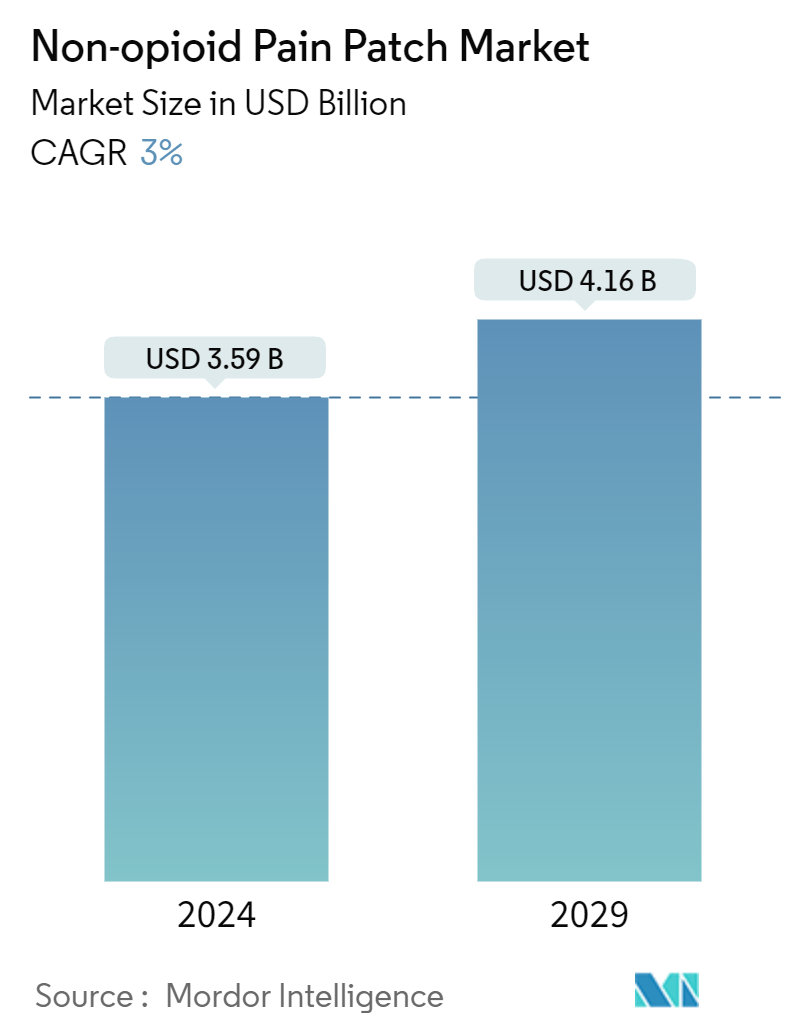
| Study Period | 2019 - 2029 |
| Market Size (2024) | USD 3.59 Billion |
| Market Size (2029) | USD 4.16 Billion |
| CAGR (2024 - 2029) | 3.00 % |
| Fastest Growing Market | Asia Pacific |
| Largest Market | North America |
| Market Concentration | Low |
Major Players
*Disclaimer: Major Players sorted in no particular order |
Non-opioid Pain Patch Market Analysis
The Non-opioid Pain Patch Market size is estimated at USD 3.59 billion in 2024, and is expected to reach USD 4.16 billion by 2029, at a CAGR of 3% during the forecast period (2024-2029).
Factors such as an increase in the burden of pain-related diseases, a rise in research and development of non-opioid patches, and benefits associated with non-opioid pain patches over conventional medications are expected to drive market growth over the forecast period.
The growing burden of pain-related diseases such as arthritis, cancer, and inflammatory bowel diseases is anticipated to increase demand for non-opioid pain patches, thereby boosting market growth. For instance, according to the CDC data published in May 2024, it is estimated that by 2040, 78 million US adults will have arthritis. Arthritis is associated with chronic pain, leading to increased demand for effective pain management treatment, which is expected to boost market growth.
Additionally, the growing burden of cancer is expected to increase the prevalence of pain in cancer patients. It is likely to spur the demand for non-opioid pain patches over the forecast period. For instance, according to the data updated by the Spanish Network of Cancer Registries (REDECAN) in January 2023, an estimated 279,260 new cases of cancer were expected to occur in Spain by the end of 2023, out of which 42,721 were new cases of colorectal cancer, 31,282 were of lung cancer, and 21,694 were of urinary bladder cancer. Thus, the high burden of cancer is expected to increase demand for non-opioid patches, thereby boosting market growth.
Meanwhile, a few other players are conducting extensive R&D by collaborating with educational institutions to introduce new non-narcotic pain patches. For instance, in May 2022, Hisamitsu America Celebrated Salonpas Day with a Free Patch offer from a doctor-recommended OTC pain relief patch brand. Salonpas was named the number-one doctor-recommended brand of pain relief patches in the United States in 2022. However, the availability of alternative treatments and the low adoption rate of non-opioid pain patches due to unawareness are expected to impede the growth of the non-opioid pain patch market.
Therefore, due to the rise in the prevalence of pain-related diseases, coupled with the strategic activities of key players, the market studied is anticipated to witness significant growth over the forecast period. However, the availability of alternative treatments and low adoption of non-opioid patches for pain due to unawareness are expected to hamper market growth.
Non-opioid Pain Patch Industry Segmentation
As per the scope of the report, non-opioid pain patches are primarily used for pain relief. These patches release their medicine content through the skin surface and block the transmission of pain signals.
The non-opioid pain patch market is segmented by patch type, distribution channel, and geography. By patch type, the market is segmented as lidocaine patches, diclofenac patches, capsaicin patches, ketoprofen patches, and other patch types. By distribution channel, the market is segmented into hospital pharmacies, retail pharmacies, and other distribution channels. By geography, the market is segmented as North America, Europe, Asia-Pacific, Middle East and Africa, and South America. The report also covers the estimated market sizes and trends for 17 countries across major regions globally. The report offers the value (USD) for the above segments.
| Lidocaine Patches |
| Diclofenac Patches |
| Capsaicin Patches |
| Ketoprofen Patches |
| Other Patch Types |
| Hospital Pharmacies |
| Retail Pharmacies |
| Other Distribution Channels |
| North America | United States |
| Canada | |
| Mexico | |
| Europe | Germany |
| United Kingdom | |
| France | |
| Italy | |
| Spain | |
| Rest of Europe | |
| Asia-Pacific | China |
| Japan | |
| India | |
| Australia | |
| South Korea | |
| Rest of Asia-Pacific | |
| Middle East and Africa | GCC |
| South Africa | |
| Rest of Middle East and Africa | |
| South America | Brazil |
| Argentina | |
| Rest of South America |
Non-opioid Pain Patch Market Size Summary
The non-opioid pain patch market is poised for growth, driven by an increasing prevalence of pain-related diseases and advancements in research and development. The market's expansion is supported by the rising demand for non-opioid alternatives due to the challenges posed by the opioid crisis. The COVID-19 pandemic initially disrupted the market by affecting pain management services and supply chains, but it also highlighted the need for non-opioid solutions as routine chronic pain services were halted. This shift has led to a greater focus on developing non-opioid pain patches, which offer benefits over traditional medications, such as reduced dependency on opioids and improved quality of life for patients with chronic conditions like diabetes and arthritis. The market is characterized by the presence of key players engaging in strategic collaborations and product launches to enhance their offerings and capture a larger market share.
North America is expected to witness significant growth in the non-opioid pain patch market, fueled by the high prevalence of chronic pain and cancer-related pain in the region. The market's growth is further supported by the increasing scrutiny of opioid use by government authorities, prompting a shift towards non-opioid alternatives. The introduction of innovative products, such as lidocaine patches, and the strategic activities of major market players are anticipated to drive market expansion. Despite the competitive landscape and the presence of alternative treatments, the non-opioid pain patch market is expected to grow, driven by the need for effective pain management solutions and the ongoing development of new products to meet consumer demands.
Non-opioid Pain Patch Market Size - Table of Contents
1. MARKET DYNAMICS
- 1.1 Market Overview
-
1.2 Market Drivers
- 1.2.1 Increasing Burden of Pain-related Disorders
- 1.2.2 Rising R&D in Pain Management Treatments
- 1.2.3 Benefits Associated with Non-opioid Pain Patches Over Conventional Medications
-
1.3 Market Restraints
- 1.3.1 Availability of Alternative Treatments
- 1.3.2 Low Adoption Rate of Non-opioid Pain Patch due to Unawareness
-
1.4 Porter's Five Forces Analysis
- 1.4.1 Bargaining Power of Suppliers
- 1.4.2 Bargaining Power of Buyers/Consumers
- 1.4.3 Threat of New Entrants
- 1.4.4 Threat of Substitute Products
- 1.4.5 Intensity of Competitive Rivalry
2. MARKET SEGMENTATION (Market Size by Value - USD)
-
2.1 By Patch Type
- 2.1.1 Lidocaine Patches
- 2.1.2 Diclofenac Patches
- 2.1.3 Capsaicin Patches
- 2.1.4 Ketoprofen Patches
- 2.1.5 Other Patch Types
-
2.2 By Distribution Channel
- 2.2.1 Hospital Pharmacies
- 2.2.2 Retail Pharmacies
- 2.2.3 Other Distribution Channels
-
2.3 By Geography
- 2.3.1 North America
- 2.3.1.1 United States
- 2.3.1.2 Canada
- 2.3.1.3 Mexico
- 2.3.2 Europe
- 2.3.2.1 Germany
- 2.3.2.2 United Kingdom
- 2.3.2.3 France
- 2.3.2.4 Italy
- 2.3.2.5 Spain
- 2.3.2.6 Rest of Europe
- 2.3.3 Asia-Pacific
- 2.3.3.1 China
- 2.3.3.2 Japan
- 2.3.3.3 India
- 2.3.3.4 Australia
- 2.3.3.5 South Korea
- 2.3.3.6 Rest of Asia-Pacific
- 2.3.4 Middle East and Africa
- 2.3.4.1 GCC
- 2.3.4.2 South Africa
- 2.3.4.3 Rest of Middle East and Africa
- 2.3.5 South America
- 2.3.5.1 Brazil
- 2.3.5.2 Argentina
- 2.3.5.3 Rest of South America
Non-opioid Pain Patch Market Research FAQs
How big is the Non-opioid Pain Patch Market?
The Non-opioid Pain Patch Market size is expected to reach USD 3.70 billion in 2025 and grow at a CAGR of 3% to reach USD 4.29 billion by 2030.
What is the current Non-opioid Pain Patch Market size?
In 2025, the Non-opioid Pain Patch Market size is expected to reach USD 3.70 billion.


